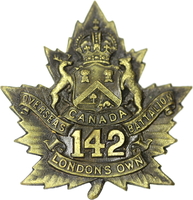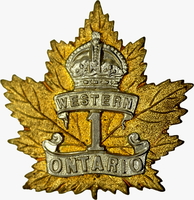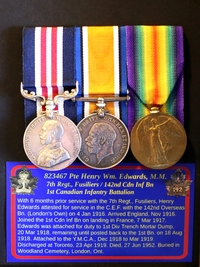
823467 Private Henry William Edwards, M.M.
7th Regiment "Fusiliers"
142nd Overseas Battalion (London's Own)
1st Canadian Infantry Battalion
By: Capt (ret'd) Michael M. O'Leary, CD, The RCR
Henry William Edwards was born in London, England, on 24 Sep 1872. Having emigrated to Canada, Edwards (age 39) and his wife Alice (38) are shown in the 1911 Canadian Census for Walkerville, Ontario. The couple have three children at home; Alice F. (12), Ethel (10), and Henry John (9).
Edwards attested for service in the Canadian Expeditionary Force (C.E.F.) with the 142nd Overseas Battalion (London's Own) at London, Ont., on 4 Jan 1916. A 44-year-old carpenter, Edwards was described on his attestation paper as 5 feet 2 inches tall, weighing 119 pounds, with a 33 1/4-inch chest, a fair complexion, blue eyes, and dark brown hair. Edwards claimed six months prior service with the 7th Regiment, Fusiliers, which was the local Militia infantry regiment in London. His religious denomination was Church of England. Edwards identified his wife, Alice Edwards, as his next of kin, with her address recorded as 41 Wreay St., London, Ont. A Particulars of Family form completed on 18 Oct 1916 recorded that the couple had three children; Henry John (14), Alice May (17), and Ethel (15).
On attesting with the 142nd Battalion, Edwards was given the regimental number 823467. The 142nd (London's Own) Battalion, C.E.F. was based in London, Ont., where the unit began recruiting in late 1915. After sailing to England in November 1916, the battalion was absorbed into the 23rd Reserve Battalion, C.E.F. on 11 Nov 1916.
Commencing November, 1916, Edwards established a monthly Pay Assignment of $20 to be sent to his wife. As a Private in the C.E.F., Edwards was paid $1.00 per day play an additional ten cents daily field allowance. His pay assignment represented about two-thirds of his monthly pay. Alice Edwards also received $20 monthly Separation Allowance, which had begun in March, 1916. The amount of separation allowance would increase to $25 per month in December, 1917, and to $30 in September, 1918.
Edwards arrived in England with the 142nd Battalion aboard the S.S. Southland on 11 Nov 1916. The following day he was transferred to the 23rd Battalion at Dibgate. He would remain with the 23 Bn. until 4 Jan 1917 when he was struck off the strength and transferred to the 4th Reserve Battalion at West Sandling. Two more months would go by before he was transferred again. This time it was to proceed overseas, and he was taken on the strength of the 1st Canadian Infantry Battalion on landing in France on 7 Mar 1917.
Arriving at the Canadian Base Depot on 9 Mar 1917, Edwards would wait until 31 Mar 1917 before he left the Depot for the 1st Canadian Entrenching Battalion, arriving on 2 Apr 1917. This Divisional Troops unit was employed as a ready labour force and by design its troops were a forward reserve of reinforcements for the division's fighting battalions. They were also used as labour forces to maintain and build trenches or other work as needed.
After less than two weeks with the entrenching battalion, Edwards departed the unit on 13 Apr 1917 to proceed to the 1st Cdn. Inf. Bn., joining the unit the same day, one of the many reinforcements joining the Canadian Corps after the Vimy Ridge assault of 9-10 Apr 1917.
The 1st Battalion's experiences in the months after the attack on Vimy Ridge followed the cycle of rotations in forward trenches, support trenches, and reserve positions that would characterize the infantry experience of the Great War. Between mid-April and mid-July, the Battalion would cycle through the forward line of trenches twice, including the Capture of Fresnoy in early May. Each rotation in the front lines was about four days between relief operations. Like many soldiers of the war, Edwards experience was one of that steady cycle between trenches and reserve, without major incidents that necessitated entries in his service record.
On 8 Jul 1917, Edwards was tried by a Field General Court Martial. His crime was being absent without leave from 10 p.m. on 7 Jul until 3 a.m. on 8 Jul 1917. Edwards was tried and convicted, receiving as punishment 28 days Field Punishment No. 1. His sentences was confirmed, and also commuted to 5 days' punishment, by the Brigade Commander. Field Punishment No. 1 consisted of extra work and drill and the penance of being secured standing to a fixed object for an hour or more each day.
Edwards was posted to the Canadian Corps Reinforcement Camp (C.C.R.C.) on 11 Oct 1917. Two weeks later, on 25 Oct 1917, he was admitted to No. 1 Canadian Field Ambulance with appendicitis. He was discharged and returned to duty on 1 Dec 1917.
Rejoining the 1st Cdn. Inf. Bn. on 16 Feb 1918, Edwards reported sick again the following day. On 17 Feb 1918, he was admitted to No. 2 Canadian Field Ambulance with "P.U.O." (pyrexia of unknown origin, a commonly used label for trench fever). Edwards was discharged to duty on 25 Feb 1918.
On 20 Mar 1918, after another month with the Battalion, Edwards was attached for duty to 1st Div Trench Mortar (T.M.) Dump. He remained here until he was posted back to the 1st Battalion on 18 Aug 1918.
Edwards was attached to the Y.M.C.A. on 18 Dec 1918, and remained with that organization until 11 Mar 1919 when he was posted to the Western Ontario Regimental Depot (W.O.R.D.) en route to his return to Canada. The W.O.R.D. was part of the regionally based reinforcement system created in March 1917, establishing named Depots taking in troops from battalions raised in those areas in Canada and providing reinforcement drafts to similarly designated fighting units. The 1st Cdn. Inf. Bn., having been originally formed from drafts of soldiers from south-western Ontario Militia units, was associated with the W.O.R.D. These Depots also became the parent unit for any soldiers returned to England from their affiliated battalions in France and Flanders.
Struck off the strength of the Overseas Military Forces of Canada (O.M.F.C.) on sailing for Canada on 14 Apr 1919. On sailing, he was taken on the strength of No. 2 District Depot, Toronto, Ont.
On 23 Apr 1919, Edwards was struck off the strength of the C.E.F. at No. 2 District Depot, Toronto, Ont. (Edwards' unit on his Discharge documents is erroneously recorded as "1st Battalion, Canadian Engineers, probably a misconstrued combining of 1st [Canadian Infantry] Battalion, and the belief that the C.R.T. was an Engineer unit.) He was issued a Class "A" War Service badge, number 286102. Edwards' intended place of residence was the family home on Wreay Street in London, Ont. On 23 May 1919, this was later changed in his records to 71 Emery St, London, Ont.
Edwards was entitled to a War Service Gratuity of $420. In addition to this, Alice received a further subsidy of $180. These were paid to them in installments between May and September, 1919.
Henry William Edwards was gazetted in the London Gazette, Issue No. 31430, dated 3 Jul 1919, as a recipient of the Military Medal. Awards with Gazette dates this late are usually attributed to the fast paces warfare of the final months of the war: Canada's 100 Days. Unfortunately, citations for Military Medals awarded late in the war have rarely survived.
For his service in the C.E.F., Edwards was entitled to receive, in addition to his Military Medal, the British War Medal and the Victory Medal. These were despatched to him at 225 Cathcart St., London, Ont., on 18 Oct 1922.
Henry William Edwards died on 27 Jun 1952. The cause of his death was recorded as acute coronary sclerosis, which was not attributed to his wartime service. He is buried in Woodland Cemetery, London, Ont. The veteran's death card held by Library and Archives Canada notes that his next of kin at the time of his death was his daughter, Mrs. Alice Woods, 433 Burbank St., London, Ont.
Pro Patria
Visit a randomly selected page in The O'Leary Collection (or reload for another choice):
- The O'Leary Collection; Medals of The Royal Canadian Regiment.
- Researching Canadian Soldiers of the First World War
- Researching The Royal Canadian Regiment
- The RCR in the First World War
- Badges of The RCR
- The Senior Subaltern
- The Minute Book (blog)
- Rogue Papers
- Tactical Primers
- The Regimental Library
- Battle Honours
- Perpetuation of the CEF
- A Miscellany
- Quotes
- The Frontenac Times
- Site Map
QUICK LINKS
The O'Leary Collection—Medals of The Royal Canadian Regiment
Newest additions:
![]()
![]() SB-12725 Private Henry "Hank" Ard
SB-12725 Private Henry "Hank" Ard ![]()
WIA at Hill 187, Died of Wounds in Japan
![]()
![]() 2355331 Lance Corporal Albert Lorking
2355331 Lance Corporal Albert Lorking
Wounded in action, later a War Amps representative.
![]()
![]() 4334 / 477996 Pte Isaac Hamilton Wilcox
4334 / 477996 Pte Isaac Hamilton Wilcox
Permanent Force, South Africa, and C.E.F.
![]()
![]() 477019 Private Harold Ashcroft
477019 Private Harold Ashcroft
Transferred to the Tunnelers.
![]()
![]() 734231 Private Clark D. Thompson
734231 Private Clark D. Thompson ![]()
The older Thompson brother, killed in action.
![]()
![]() 733849 Private Norman Parker Thompson
733849 Private Norman Parker Thompson
The younger Thompson brother; post-war service in the Special Guard.
![]()
![]()
![]() A305 / 400305 Private Andrew Walker
A305 / 400305 Private Andrew Walker ![]()
"Previously reported Wounded, now Killed in Action."
![]()
![]() 823298 Pte Thomas Patrick Steele, M.M.
823298 Pte Thomas Patrick Steele, M.M. ![]()
… for gallant conduct in the field …
![]()
![]() P13066 Sergeant Harold Thompson
P13066 Sergeant Harold Thompson
Instrumental Soloist for over 20 years of Canadian Army service.
![]()
![]() 9609 / 477728 Private Albert Edward Piper
9609 / 477728 Private Albert Edward Piper
"Arrived from England as a STOWAWAY …"



